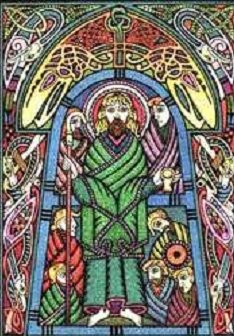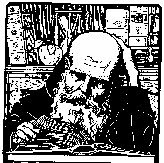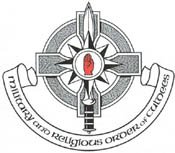
Druids and Culdees; Lugh and Jesus; Danu and Brigid; what do they have in common? In one important way, they are all victims of Evolution and 19th Century Rationalism. Allow me to explain: following Darwin’s presentation of his all-encompassing theory of life and its development, Europe was busting at its proverbial seams to apply his theories to every area of society: politics, philosophy and religion. In his hugely influential theories on religion, Englishman Edward B. Tylor, theorized that the religions of men went through a four-fold evolution: first the idea of ‘a soul’ leading to animism or spiritism; as societies stratified, so did their gods, leading to polytheistic aristocracies; then, as aristocracies struggled and monarchs emerged, so did monotheisms develop; and lastly, enlightened society would be projected to eventually ‘ditch’ their monotheism for the apparently all-powerful ‘evolutionary process’ in order to advance and prosper (after all ‘evolution’ had the power to create and destroy gods, didn’t it?). The foregoing is yet at the heart of the current Humanistic tide.
Anyone with a calendar would realize that these matters occurred at the same time as the Celtic and Magickal Revivals. These movements operate in a slightly modified manner; however, in that they hold to the concepts of the “noble savage”, “primordial genius”, and the “arcane mystery solution,” none of which are very evolutionary. In point of fact, this makes the Wiccans, and Shamans et al, appear quite opportunistic; allow the Rationalists to demolish the ascendant Monotheism, while they recruit from the disillusioned masses. Be that as it may, Tylor and his descendants ran into a bit of trouble. Eventually, ignoring all the facts finally caught up with them (as it has with their cousins in the physical sciences) and monotheisms were cropping up, out of turn, in all sorts of primitive societies where the supposed oppression of the missionaries had not yet reached; how terribly inconvenient!
So, what do we make of the Celtic religion in view of all of this? First anyone must humbly admit that the meager evidence which we have to draw from is an enormous hurdle to accurately understanding the faith of the Celts. Second, the ‘spin doctors’ of the Romans, and others of vested interests, make what evidence they provide a critical exercise in reading between the lines. Thirdly, those helpful souls of the 19th century in their love or hatred of the Celts and their ill-equipped desire to fill in the many blanks has left us with a very distorted landscape that must always be corrected prior to moving forward. Those who seek to glean the truth of Celtic belief must ever ‘do battle’ with the war of adjectives and absolutism which has been the frequent work-tools of the trade, sadly.
Back to Druids and Culdees; Lugh and Jesus; and Danu and Brigid. Whatever the sources and whatever the intent, it is clear that the so-called gods of the Celts were their ancestors. Following the origin myths of the Celts, it is apparent that they were an insular group, that was largely nomadic, and didn’t conduct a great deal of ‘borrowing’ from the people they encountered (frankly, they were usually fighting with them). There can be a strong case made for the Scythian forebears of the Celts being at the vanguard of knowledge, science and social development. The Greeks received their knowledge and writing from the Egyptians according to the ancients, and the Egyptians received theirs from the Scythians. As an aside: much has been said regarding Celtic funerary influence being derived from their Egyptian contact; however, dolmens exist along the Steppes and the River Danube where Egyptian contact did not occur. The reverse influence may in fact be true. There is cogently, evidence of highly developed writing millennia before the Christian era and Celtic forebears are proclaimed as being at the forefront of these developments, yet they are often depicted as illiterate and unlearned (part of the Julian Barbarian slur). I would propose that the Celts’ frequent migrations made enduring forms of literature unlikely, and that situation was as much the impetus for a strong oral tradition as the traditional Druidic taboo. The under appreciated standing stones of the British Isles (approx. 400) with their Ogham engravings, display true genius of complex language ability and a clear connection with their continental kindred.
The 19th century Reconstructionists and Revivalists were evidently enamored with solar gods and sought at every turn to blur Celtic versions with the traditions of other cultures without evidence or warrant. Lugh was an admired patriarch of the Tuatha de Danaans and became the focus of the deep appreciation that the Milesians held for their society and abilities. Such ‘hero worship’ of a conquered predecessor culture is unparalleled, yet the Milesians strongly held to their own traditions. It is telling that with the advent of the Christian faith in Ireland (already in existence when St. Patrick arrived), that Jesus was not compared with Lugh. In fact Jesus is only tangentially compared to the enigmatic Yesu, very much in the same manner as the Apostle Paul presented Him as “The Unknown God” to the Athenians on Mars Hill (see “Eternity in their Hearts” by Don Richardson for practical examples of how the Christian faith finds welcomed entry into primitive cultures). Along the same lines, Danu becomes blurred with 6th century St. Brigid over the slightest cultural similarities and the ever present repetition of certain names among the Celtic peoples (so much so that it makes genealogy a strident challenge regularly). Lastly, the confusion of the Druids and the Culdees: there is so little that can be said definitively regarding the Druids (or the Culdees for that matter) and it is a frequent feature that mere opinions are flown as banners in the discussions of these groups, when sober study is more appropriate. The Druids were a fixture in Celtic society from their Scythian roots (i.e. Caicher) and in early Milesian society they were singled out for great distinction even by their clothing. No king would dare act without consulting them and all feared their excommunication. They were scholarly in their knowledge of natural philosophy, astronomy, bardic history, and many other crafts and skills. They were not dynastic or from a particular family line, although the more popular examples were certainly from royal families. Other than this, little is known with certainty, but much is conjectured. Although Celtic culture, and Druids by extension, was at long-standing war with the Romans and later the Anglo-Saxons, they readily accepted the Culdee faith. Indeed the Culdees frequently found themselves at conflict with the Roman factions and their puppets, yet they were steadfastly staunch in their Christian traditions.
In spite of the Christophobia of most New Age groups, the Culdees and the Druids got along remarkably well: St. Patrick sat at an equal table with druids and Kings in the reformation of the Irish Brehon laws; St. Columcille called Jesus his Druid and resisted the movement to discard the Bards from Irish society. In fact they lived peacefully together on Iona, which had been a Druidic community of longstanding. Welsh traditions report similar camaraderie and seamless conversions. One Archdruid is reported as having ordered the welcoming of the Christian message in Ireland as it would make their paganism stronger (a provocative if not inscrutable reference). All of this being said, it is the nature of the Celts to be practical and to hold small packets of truth without feeling the need to take them to logical conclusions or expand upon them. They were not of the sort to examine the number of angels dancing upon the head of a pin as perhaps the Romans or Dutch might, but their faith was always characterized by being practical, community practiced, outreaching, and humble.



No comments:
Post a Comment